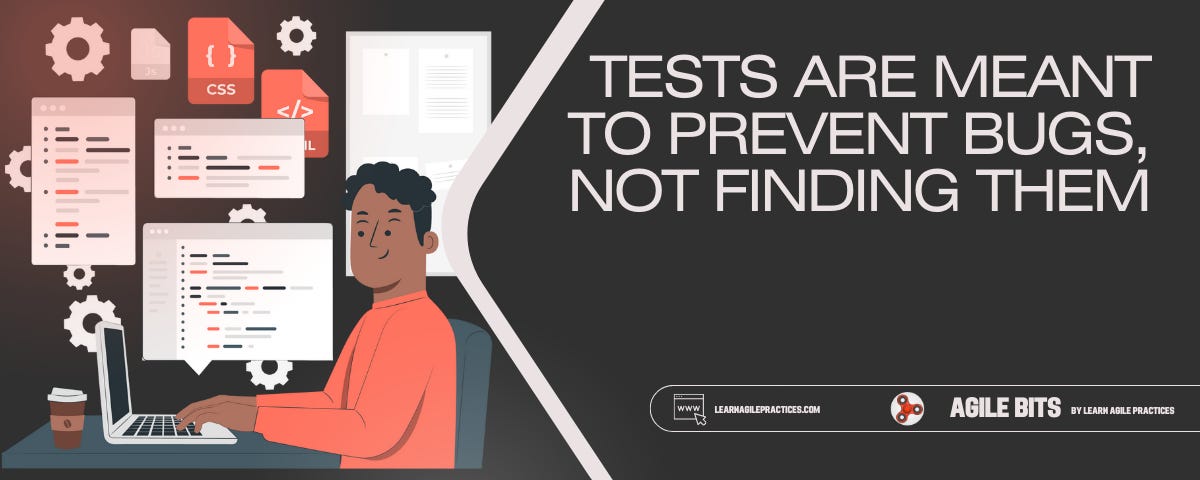Tests are meant to prevent bugs, not finding them
Most people think to QA and tests as something we do to find bugs and defects - instead, we should think to those activities as something to prevent them.
Hello, developers! 🚀
Welcome back to the Learn Agile Practices newsletter, your weekly dose of insights to power up your software development journey through Agile Technical Practices and Methodologies!
Before starting, I quickly remind you that my brand new Test-Driven Development 101 5-day Email Course is available: it is the introduction to TDD I wish I had when I started learning it, so I think you will find it very useful!
As a subscriber to my newsletter, you can have it with a 10EUR discount! 👇
Now, let's dive into today's micro-topic!
In short
🛡️ In software development, testing should be seen as a method to prevent defects from reaching production, rather than just identifying them after development.
🚀 By shifting left, developers focus on the Lean principle of building quality in from the start. Early testing, automation, and QA practices allow for bugs to be avoided upfront, ensuring more robust software and reducing costly late-stage fixes.
💡 Preventing bugs early in development is cost-efficient, increases confidence in code, and speeds up delivery. Developers can refactor and innovate with more assurance, as automated tests provide a safety net against unexpected issues.
🧑💻 Test-Driven Development epitomizes this preventive approach. Writing tests before code ensures that every piece of code is linked to a real requirement, significantly reducing the likelihood of bugs making it into production.
Prevention instead of late discovery
In the world of software development, testing is often misunderstood. A quote from social media captures this perfectly:
Tests are not meant to discover defects, but to prevent them - prevent them to reach production.
This shifts the perspective entirely. Instead of treating tests as bug-finding tools after development, we should think of them as safeguards integrated into the process, ensuring bugs don't make it into the code in the first place.
Shift Left, Shift Smart
This is where the concept of "shifting left" comes into play. Approaches like test automation, Test-Driven Development (TDD), and early Quality Assurance (QA) work best because they embed quality into the development process. Rather than focusing on catching defects at the end, we shift our mindset to preventing them upfront.
By integrating tests early, you’re building software that’s more robust by design. You prevent bugs, rather than discovering them later when fixing them is more costly and time-consuming.
Practices such as Test-Driven Development, Acceptance Test-Driven Development (aka Behavior-Driven Development), Trunk-Based Development, Continuous Integration, Pair/Ensemble Programming - all of them shift QA as left as possible to anticipate any kind of issue and solve them as part of the process, following the Lean principle of building quality in.
The Benefits of Preventing Bugs During Development
Here are a few reasons why preventing bugs is a far better approach than simply hunting for them:
Cost efficiency: The earlier a defect is caught, the cheaper it is to fix. Tests integrated in development reduce rework.
Confidence in your code: Knowing that every change is backed by tests allows developers to refactor boldly, with the safety net of automated checks.
Faster delivery: By preventing bugs, you spend less time in firefighting mode and more time delivering valuable features.
A Preventive Approach in Action
Test-Driven Development in particular is the perfect example of how to integrate preventive testing into your process. Instead of writing code and later testing for errors, you write tests before the code itself. This ensures that every line you write is driven by a real requirement, enforcing the need to have a clear idea of the expected behavior before implementing it and making it harder to have bugs sneaking in.
By adopting this preventive mindset, you are no longer "looking" for bugs—they simply don’t make it into production in the first place. You will rarely use a debugger again on code produced this way.
Until next time, happy coding! 🤓👩💻👨💻


